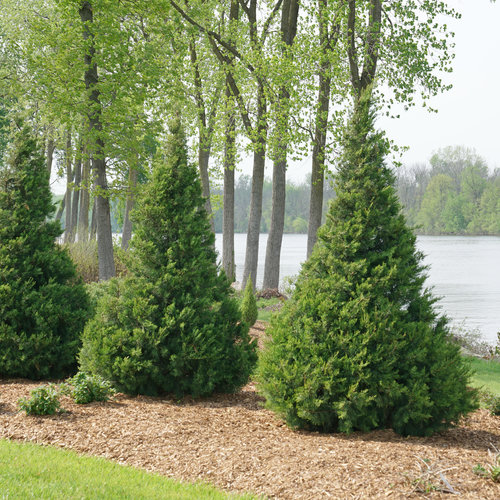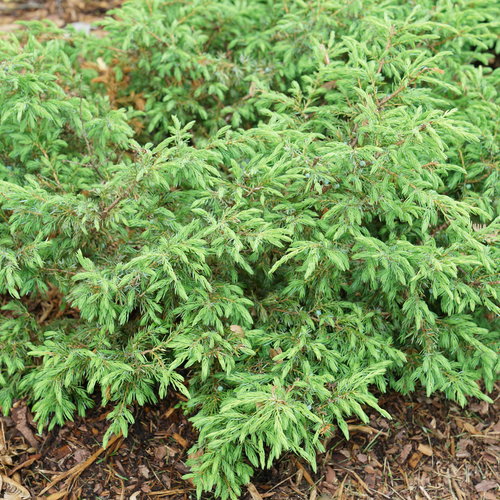Juniper - The Ultimate Growing Guide from Proven Winners®
This versatile evergreen conifer provides year-round interest and visual appeal in the landscape

Buy juniper plants - Order online and have them shipped right to your door
Juniper (Juniperus) is a popular tree or shrub that is commonly used in home landscapes. This evergreen conifer produces fan-shaped needles in colors of green, blue or gold, providing color and soft texture to beds, borders, and containers. Female plants produce showy berry-like blue cones, while male cones are yellow or tan, resembling miniature pine cones. Juniper berries are used to make gin, as a spice, and for medicinal purposes.
This cypress relative occurs natively throughout the Northern Hemisphere, growing in most hardiness zones. There are many types of juniper, with varieties in a wide range of sizes and forms, from upright trees up to 130 feet tall, to petite ground covers just 6 inches high. This versatile ornamental plant can be used in foundation plantings, mixed borders, rock gardens, containers, as hedging or screening, or as a stand-alone focal point.
PLANTING & JUNIPER CARE
How to plant: Choose a planting site with full sun and well-draining soil. Juniper will benefit from afternoon shade in hotter climates. Follow these steps to plant juniper trees and shrubs. Spacing will vary according to the variety. As a general rule, allow for the maximum width in between each plant. For most garden varieties, this can range from 3 to 10 feet.
- Loosen soil in the planting area to improve drainage.
- Dig a hole 2 to 3 times as wide and just as deep as the root ball.
- Remove the plant from its nursery container and gently tease out potbound roots.
- Set the plant in the hole with the top of the root ball slightly higher than the surrounding soil.
- Backfill the hole with soil, tamp down lightly to remove air pockets, and water well.
- Irrigate plants regularly until established.
Soil: Juniper is an acid-loving plant, and is tolerant of most soil types. Plants perform best in rich, well-draining soil. Poor drainage can cause root rot. For dwarf specimens planted in containers, use a high-quality, all-purpose potting mix, and make sure containers have adequate drainage holes.
Watering: Once established, juniper needs little supplemental water in most growing regions. Provide supplemental water in arid climates, or during prolonged heat or dry spells. Avoid overwatering to prevent root rot and other diseases.
Fertilizing: Juniper plants need little or no supplemental fertilizer. If desired, apply a slow-release granular fertilizer in early spring according to package instructions. Use an all-purpose fertilizer or other fertilizer specially formulated for acid-loving trees and shrubs.
Pruning: Juniper plants look best when allowed to retain their natural shape and size. In early spring, remove any dead, damaged or diseased branches and lightly shape plants as needed. Older growth at the center of plants can die out and will not regenerate. Avoid cutting branches past live growth, as this will result in unattractive brown gaps that will remain permanently.
TRY THESE PROVEN WINNERS® VARIETIES
Add these juniper varieties in your landscape:
Zones: 4-8 |
Zones: 4-9 |
Zones: 2-7 |
Zones: 4-9 |
JUNIPER ALTERNATIVES FOR FIRE-PRONE AREAS
Evergreen conifers, including juniper, produce resinous sap that is flammable, making them hazardous in fire-prone areas. Choose more fire-resistant trees and shrubs such as Japanese maple, smoke tree, crape myrtle, lilac, sumac, or flowering currant.
Find more fire-resistant plants.
FREQUENTLY ASKED QUESTIONS
Is juniper a bush or tree?
Juniper is a tree or shrub, depending on the species or variety. Plants can have an upright, spreading, weeping, or ground cover habit.
Do juniper trees grow fast?
Juniper trees grow at different rates, depending on the variety. Fast-growing trees can reach up to 130 feet tall. Most garden varieties of juniper have a slow to moderate growth rate.
Are juniper trees high maintenance?
When provided with the right growing conditions, juniper tree is drought tolerant, pest and disease resistant, and virtually carefree.
Do junipers need a lot of water?
Once established, juniper plants need little or no supplemental water, with the exception of prolonged heat or dry spells.
What is the lifespan of a juniper bush?
Juniper is a long-lived evergreen conifer that thrives year after year. Common landscape varieties can last 30-70 years or more.
How big does a juniper bush get?
Juniper shrubs can reach up to 15 feet tall and wide, though many varieties remain smaller. Choose varieties that won’t outgrow their space.
Where is the best place to plant juniper bushes?
Juniper shrubs prefer a sunny site with well-draining soil.
What are juniper bushes good for?
Juniper bushes are versatile in the landscape, adding year-round color, structure and texture. Use in foundation plantings, mixed borders, mass plantings, as hedging, or in containers.
Do junipers like sun or shade?
Junipers prefer full sun, and will benefit from some afternoon shade in hotter climates.
JUNIPER LANDSCAPING IDEAS
Juniper is a versatile ornamental plant, with many uses in the landscape. Here are some ideas on how to use juniper in your yard:
- Plant a slender upright variety in a row to screen a fence, property line, or unsightly view.
- Mass a ground cover juniper along a slope to help stem erosion. Find more of the best erosion-control plants.
- Use an upright or pyramidal juniper as a hedge to divide different areas of the yard.
- Place decorative containers on either side of a front-yard sidewalk and plant with dwarf junipers for a welcoming entrance to your home.
- Edge a pathway or border with a low, spreading juniper for low-maintenance appeal. Find more low-maintenance plants.
- Mass a ground cover juniper as an attractive, easy-care lawn substitute.
- In deer-prone areas, use juniper to deter hungry foragers. Find more deer-resistant shrubs.
- Plant juniper in a winter garden in combination with other trees and shrubs with winter interest. Include hellebores and early-blooming bulbs for cheerful color when little else is in bloom.
- Create a foundation planting with evergreen junipers and other ornamental shrubs for year-round curb appeal. Find more of the best foundation plants.
- Plant a colorful juniper tree in an island bed as an attractive focal point in the landscape.
- Include junipers with different sizes and shapes in a mixed border for compelling structure, textural interest, and year-round color.
JUNIPER COMPANION PLANTS
Combine juniper alongside other plants with similar growing needs of full sun and well-draining soil.
For a mixed border, plant juniper with:
- Rock ’N Round® ‘Superstar’ sedum
- Prairie Winds® ‘Apache Rose’ switch grass
- Pugster Blue® butterfly bush
- Sweet Romance® lavender
For a winter garden, combine juniper with:
- Little Goblin® Orange winterberry holly
- Arctic Sun® dogwood
- Interstella® lily of the valley shrub
- Brandywine™ viburnum
Find more on plants for winter interest.
For a shrub border or foundation planting, use juniper alongside:
- Gatsby Moon® oakleaf hydrangea
- Sweet Emotion® hardy abelia
- Soft Serve® false cypress
- Lil’ Kim® rose of Sharon
Find more of the best evergreen shrubs.
Buy Proven Winners plants:








